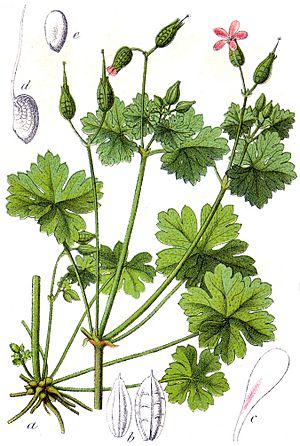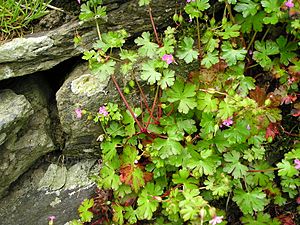Shining cranesbill facts for kids
Quick facts for kids Shining cranesbill |
|
|---|---|
 |
|
| Scientific classification | |
| Genus: |
Geranium
|
| Species: |
lucidum
|
Shining cranesbill (also called shining geranium or shiny geranium) is a pretty plant known for its bright, glossy leaves. Its scientific name is Geranium lucidum. This plant is an annual, which means it grows, flowers, and dies all within one year. It belongs to the Geranium family.
Shining cranesbill originally comes from Europe, western Asia, and North Africa. People brought it to North America as a garden plant. In some places, especially the Pacific Northwest, it has started growing on its own. Here, it is seen as an invasive species, which means it grows where it's not wanted and can harm other plants. It is also called a noxious weed.
Contents
What Does It Look Like?
The shining cranesbill is an annual plant. Its stems can grow up to about 14 inches (35 cm) long. These stems are usually brittle, fleshy, and smooth, often turning red.
The leaves are round or shaped like a kidney and look very shiny. They are divided into rounded lobes, almost two-thirds of the way deep. Sometimes, the top surface of the leaves has short hairs.
The flowers have five parts. They have sharply ridged sepals (the leaf-like parts that protect the bud). The petals are bright pink and rounded, about 0.4 inches (10 mm) across. These petals have long bases and flat blades. The flowers grow in pairs and bloom from May to August.
After the flowers, the plant produces fruits that look like capsules with a beak. These fruits have ridges and are a bit hairy, especially on the edges. They split open into five parts to release the seeds. The seeds themselves are smooth. The whole plant often turns red, especially as it gets older.
Where Does It Grow?
The shining cranesbill is originally from Europe, Asia (as far east as the Himalayas), and northern Africa. This plant is very common in Great Britain and Ireland, especially in the southwest and west. However, it is not as common in Scotland.
You can find it growing at heights of up to about 2,000 feet (610 meters). It has been grown in gardens in parts of the United States. In the Pacific Northwest, it has started growing naturally in the wild.
Where It Likes to Live
Shining cranesbill often grows on limestone rocks and walls. You can also find it in churchyards, along roadsides, on banks, in gardens, and on bare ground. It grows well in chalky or sandy soil. It can also thrive in acidic soils and shady areas.
This plant is good at spreading its seeds. The seeds are thrown out of the capsule with a small explosion. This helps the plant move up slopes and grow in small cracks in tree trunks or walls that are higher than the parent plant.
An Invasive Plant
In some parts of the United States, like California, Washington state, and the Willamette Valley in Oregon, shining cranesbill has started growing on its own. It was first found in the U.S. in 1971. Since then, it has been called a noxious weed in Washington and Oregon. This means it's a plant that causes problems for native plants or crops.
A survey in 2013 showed it was in five counties in Washington, thirteen in Oregon, and two in California. It was also found in Canada in 1982, on Vancouver Island in British Columbia. It has also been introduced to Australia and New Zealand.
When shining cranesbill grows naturally in the Pacific Northwest, it is often found with a similar European plant called herb Robert (Geranium robertianum). Herb Robert is also considered a noxious weed. In these areas, shining cranesbill grows very well in woodlands and forest clearings. It can sometimes take over and outcompete the plants that naturally grow there.
Because it can be a problem, laws have been made. For example, in Washington state, it is "prohibited to transport, buy, sell, offer for sale, or to distribute plants or plant parts, seeds in packets, blends or "wildflower mixes" of this species, into or within the state of Washington." This means you cannot move or sell any part of this plant in Washington state.
See also
 In Spanish: Geranium lucidum para niños
In Spanish: Geranium lucidum para niños



